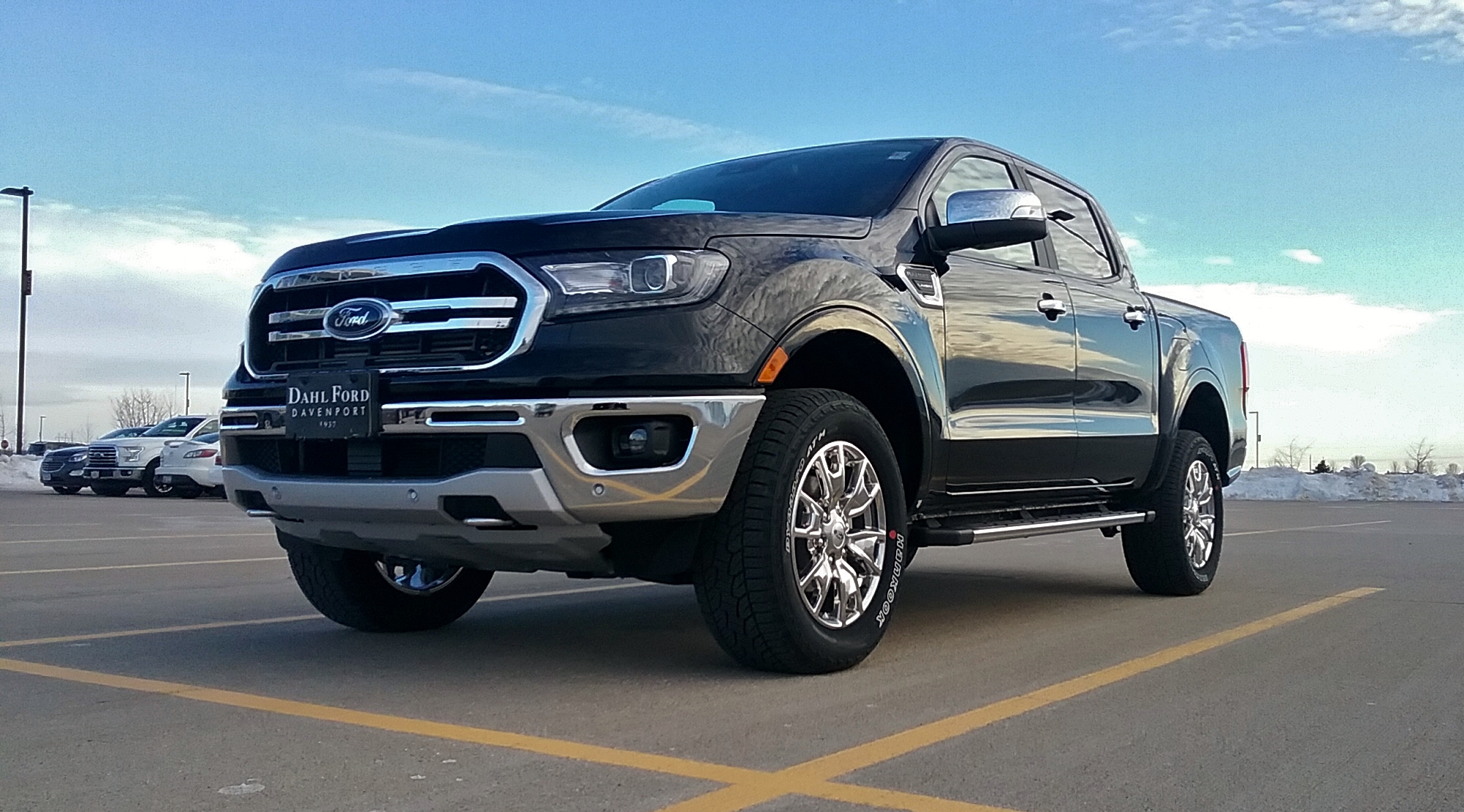
Most of the time, I’m interested in either Volvos, 1970s-era Broughams and modern Lincolns and Cadillacs. This is of course reflected here on this fine site. However, I do try from time to time to expand my horizons. Like last year, when I test drove a new 2018 Subaru Outback Limited, in between reviews for a 2015 Lincoln MKZ 2.0H and 2018 Lincoln Continental.
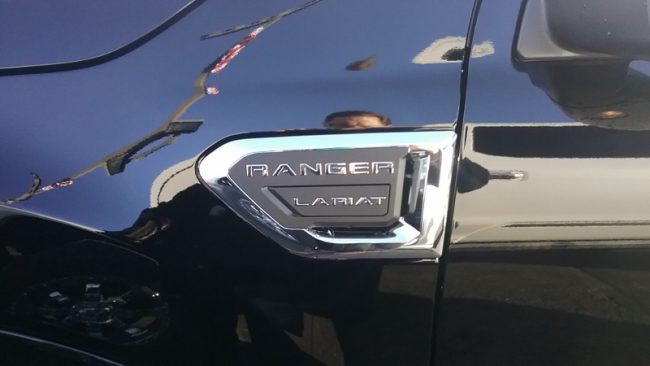
For instance, recently I decided to try out the all-new Ford Ranger. I thought it would be a good topic for a road test, as a lot of folks have been interested in the return of the smaller Ford pickup, ever since the original was discontinued after the 2011 model year.
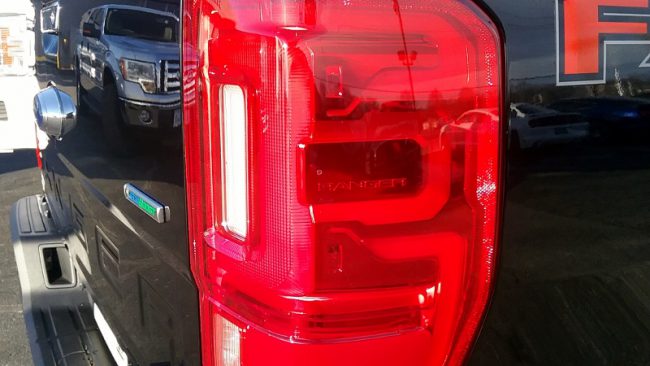
I remember those trucks, because in 2011, after being downsized from my banking job, I found myself selling new Fords in Davenport. I even sold a new Ranger. It was a basic refrigerator white standard cab model. The buyer had had his previous truck totalled when, during a police chase, the pursuee clipped his car while evading several members of the Davenport police force. He was OK, but the truck was not. So he had to get a new Ranger while they were still being produced.
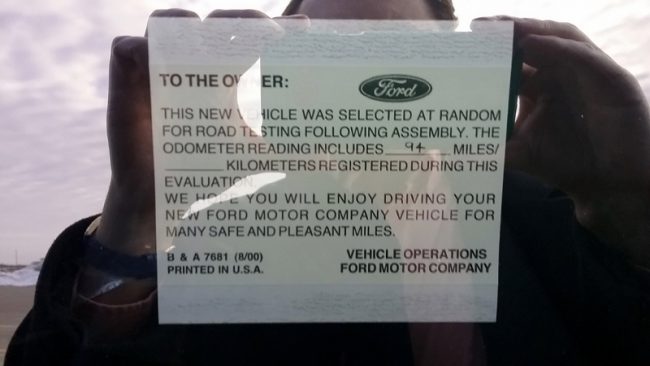
I remember driving it to the gas station after it had been detailed, to fill the tank before delivery. It was a definite small cab, but for my five foot ten frame, was fine. Though the rear window was a little too close to the back of my head for comfort. Lots of glass area, though!

I first saw a new-type Ranger at the 2018 Iowa-Illinois Regional auto show, held every February at the River Center in downtown Davenport, Iowa. It was a locked prototype in metallic gold. Didn’t look bad. And I wondered how long it would be before they became available for sale.
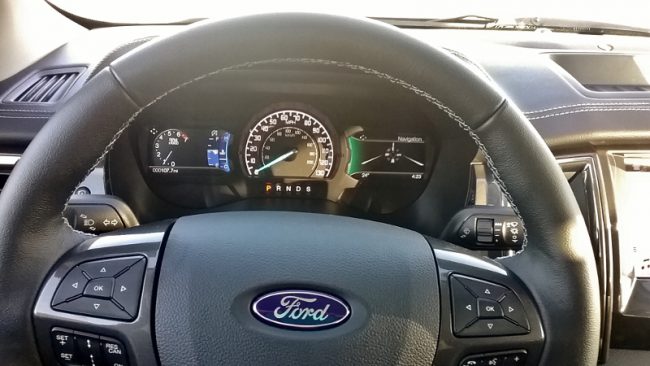
That time came early this year. A friend of mine, K. V. Dahl, runs Dahl Ford, and I messaged him recently to see if I could try one of the new Rangers out. End result: no problem. He told me to stop by and talk to the inventory manager, Mike Pepping. And so I found myself sitting in his office, shooting the breeze last Thursday afternoon.
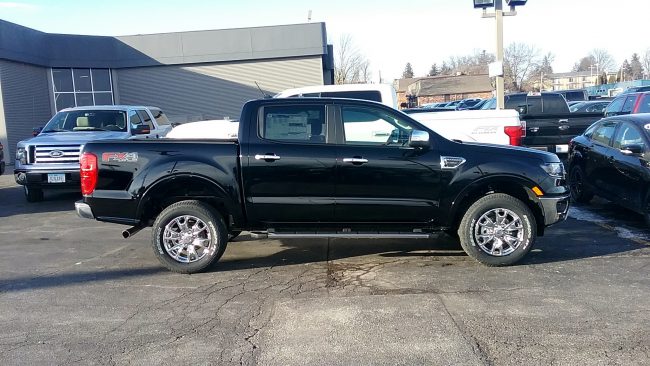
Not only did he arrange a top-of-the-line Ranger Lariat for me, their detail staff ran it through the car wash and parked it out front. Not bad! They really roll out the red carpet, considering I’m just driving and not buying. Helps knowing the right folks I guess. And K.V. is a genuine car guy, with quite a few cool old cars in his car collection, including a few previously featured tight here on RG. But I digress.
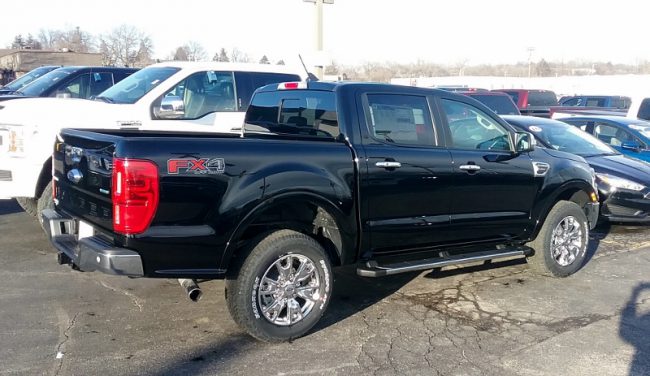
As I walked out of the showroom to check it out, one of their detailing guys was installing a dealer plate on the chrome rear bumper. Time for a walkaround before proceeding. In short, the new Ranger is pretty nice looking, especially in black with the chrome wheels and chrome running boards. I prefer its lines to the Chevrolet Colorado and GMC Canyon. While not as small as the earlier, outgoing Ranger, it is quite a bit smaller than the F150, and rolling aircraft carrier that is the F250, ha.
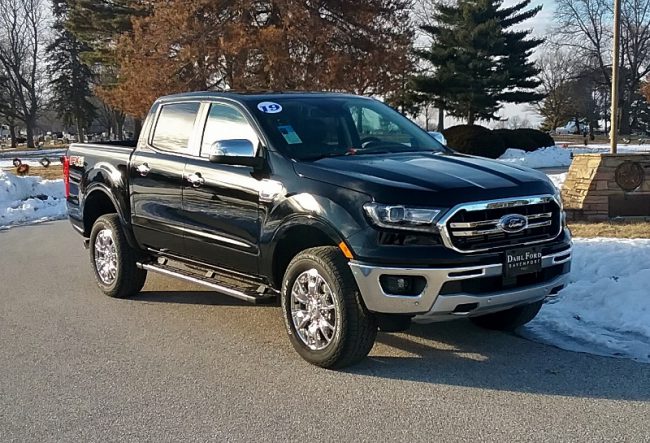
So, let’s see how this thing drives. I hopped in and pushed the now-ubiquitous start/stop button instead of turning a key. As I wheeled out of the lot, it seemed pretty composed.
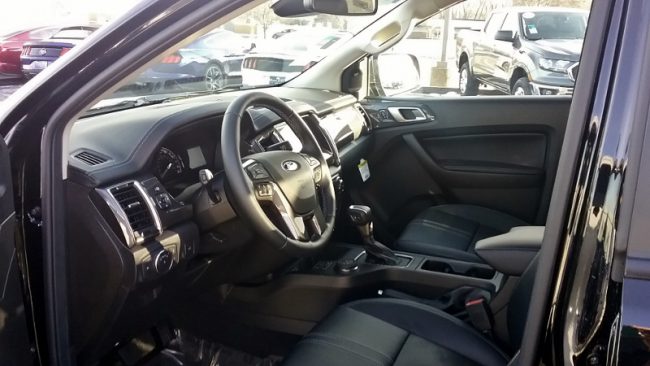
Ride on a typical pot-holed winter, Midwestern city street reminded you that you were most certainly driving a truck and not a car. But on the smooth, recently completed parkway by the casino, it was very smooth.
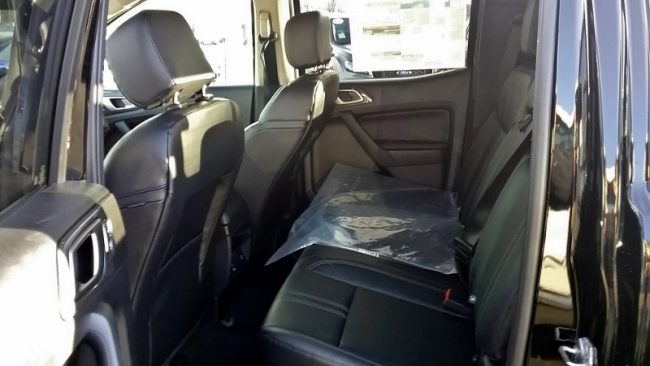
It was very quiet too. While I didn’t push too hard on the go-pedal (it only had about 100 miles on the odometer), I did get it to giddy up some, and there was an agreeable little growl from the engine when stepped on. Acceleration, no doubt due to the turbo, was very good. Handling, while of course in keeping with it being a pickup, was nonetheless pretty good as well. Certainly nothing like maneuvering a full-size Ford pickup.
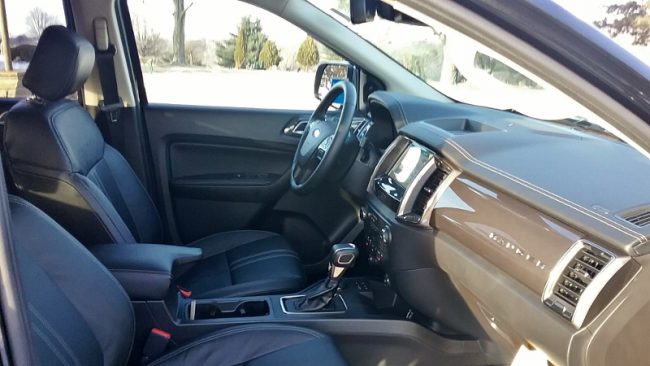
Glass area was good too. Just a few days prior to my Ranger drive, I tried out a 2017 Taurus SEL company car. And the Taurus was like the Batcave glass-wise when compared to the Ranger. Better sight lines, and the pillars just seemed way less massive.
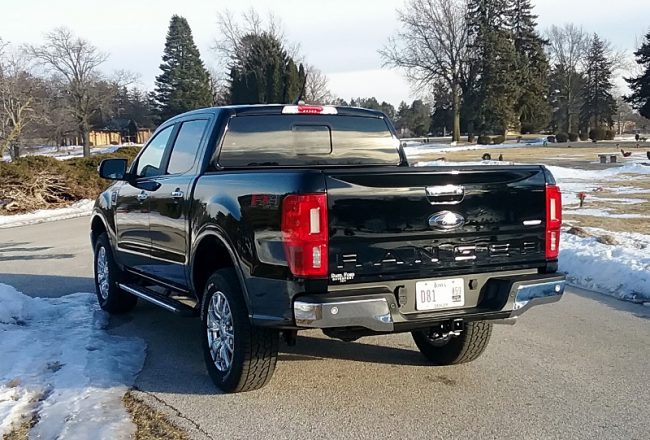
There are a lot of Mini-Me F150 styling cues, especially from the back. Though the nose is much more car-like, almost like a Focus that bulked up.
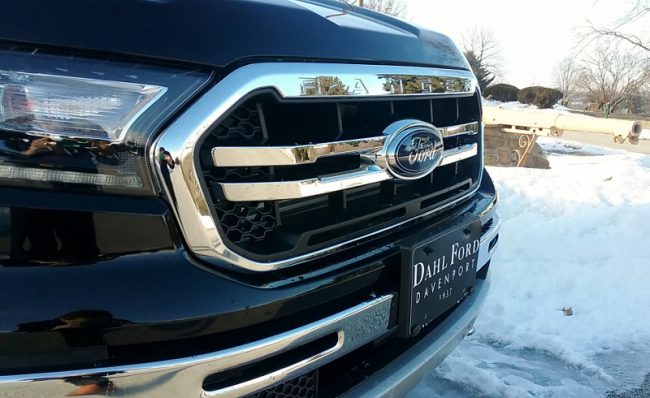
According to Ford, the plain-Jane XL starts at $24,300, the XLT at $27,940 and the top-drawer Lariat at $32,210. However, my tester was loaded to the gills, with pretty much every available factory and dealer-installed option.
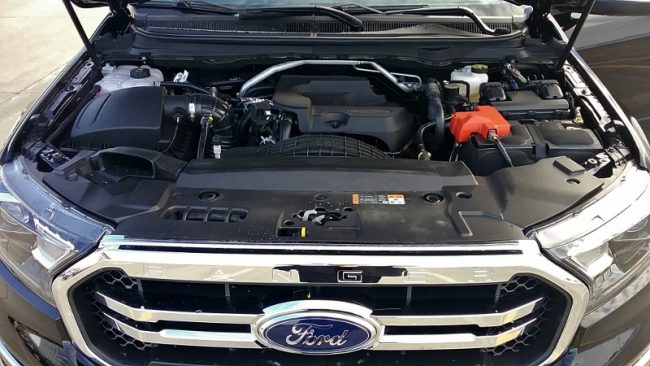
Standard equipment on the Lariat includes 2.3L turbo engine with a 10-speed automatic, rated 21 mpg city and 26 mpg highway.
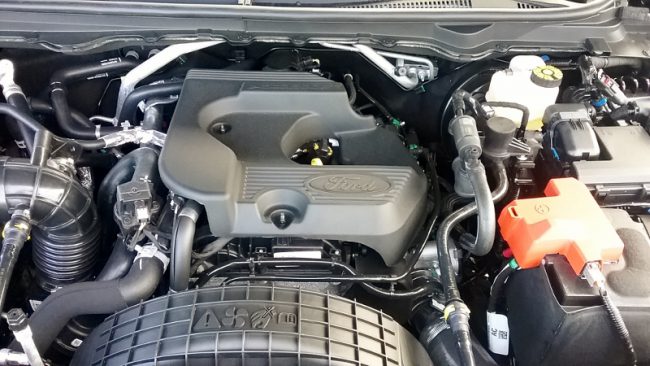
While many may likely pan the new midsize pickup, they are apparently stout. As a friend of mine, Freddy Hollingsworth, related recently:
“I’ve already seen one of these crashed in a test drive. It held up very well it rear ended a new Corolla and the Ranger pushed the trunk of the Corolla in about a foot, broke the back glass and slightly buckled the roof on the Corolla. The Ranger had no visible damage whatsoever other than the bumper being tilted lightly downward at the wheels, so these Rangers definitely have strong frames.”
Or, as Al Czervik once famously stated, “Hey! you scratched my anchor!”
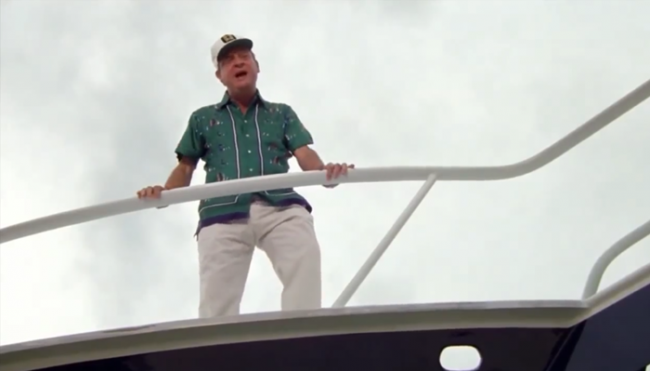
While I gave the Ranger a pretty decent drive, it was now approaching 5 PM, and since the dealership was right in the heart of rush hour central, I decided to head back. All in all, the 2019 Ranger Lariat is a pretty nice ride. Is it for everyone? No. But trucks, aren’t for everyone, though you could be forgiven for thinking that with the hundreds I see in traffic every week.
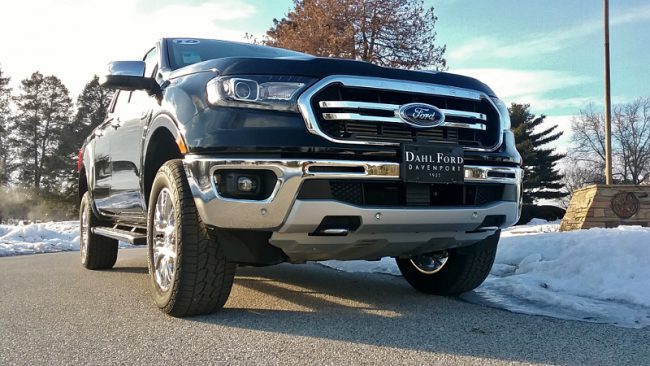
And of course, it is a brand-new model. Time will tell as to how these last, and how stout they are after they’ve been in production a few years. But as a smaller pickup, it’s an appealing vehicle. As I’ve said before, I’m not a truck guy and likely never will be, but I enjoyed my time behind the wheel of this rig.
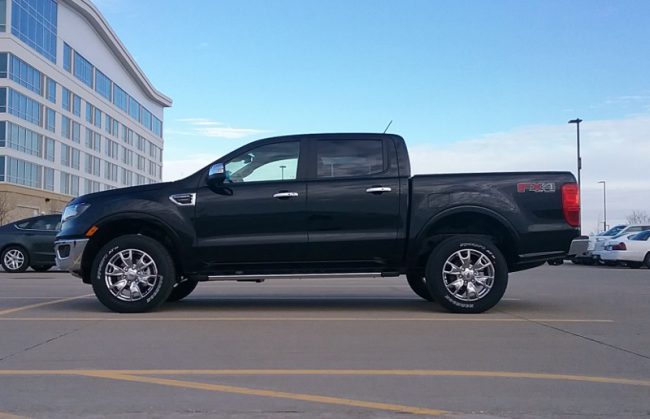
If you want sheer size and volume, probably a F150 is a better bet. But if you just want a tow vehicle for a small camper or speedboat, or to tow a motorcycle, and don’t want to pilot a plus-sized pickup, the new Ranger is worth checking out. Try one and see. Although I’ll still probably be seeking out CPO MKZs when it’s time for me to trade in the Cartier!
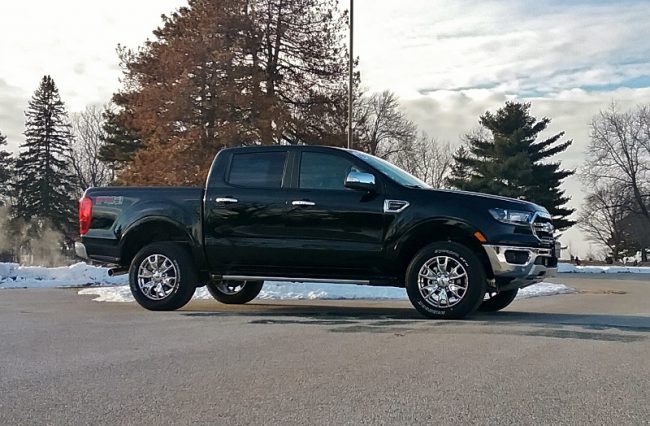







23 Comments
Ranger – all the size and capability that almost anyone would ever need in a truck, but when an F-150 is only a few bucks more (current lease deals seem to be about $10 per month difference), most will decide they want the extra space, and they won’t even pay much extra in fuel as EPA ratings are about 1 mpg different in the combined cycle. The small price and MPG difference (and lack of profit) is basically what killed off the Ranger the first time round, it will be interesting to see if anything is different this time round.
I don’t think these will appeal to the counterculture the way the 70s Japanese compact trucks did. When the original Ranger and S10 were designed in the early eighties the extra substance of six cylinders and autos indicated that they intended to supplant the full size domestic offerings and aimed at the mainstream truck buyer. Thankfully for the USA, there were no further gas shocks and the full size were kept around and eventually even updated leaving the compacts to struggle and whither.
No…they won’t. And I say that as the one-time owner of a Datsun PL620.
First order of business, is the small box. You can’t carry plywood, or drywall, or a motorcycle back there.
Second order of business, most of the diminutive box is behind the rear wheels. A load of firewood is going to make that truck more-unstable than it would on a use-oriented pickup with the box centered over the axle or even a bit forward.
Third, is going to be the crushing price tag. Lil’ Hustlers and Hiluxes sold cheaper than the benchmart economy car, the VW Type 1, back in the day. This thing, it goes without saying, is not going to sell for what a Sonic or even Mitsubshi Mirage sells. Not even for three times what they sell.
The author dryly commented that the F150 might be better for utility users, and that is of course, true here. That was NOT true when comparing the 1970s Ford or Chevrolet full-size trucks to the little imported trucks of THOSE years.
It comes down to the universal rule of thumb: A compromise product is…compromised. You cannot have room for a family, small size, luxurious interiors, space-age passive-restraints…AND a usable work platform, all in one.
Price point is an interesting problem. Our Japanese friends didn’t pay their workers much in dollar terms during the seventies. Notice the early domestics used captive compact truck imports to avoid the UAW wages. In doing so they mistakenly validated the chicken tax dance around. What would a Sentra engine, 5 speed, regular cab, made in Japan, Nissan compact pickup cost today 25k?
You’re sure hung-up on that. But Virtue-Signalling is not on the list of most potential buyers for a vehicle. The wage a business pays, is between the business and the people it hires.
And if I recall correctly, none of the Japanese or Korean companies have gone bankrupt. Two UAW-Friendly American firms, HAVE.
And their products are priced out of reasonable reach of a huge segment of the American population.
Japan is not a totalitarian state; and the workers have the right of refusal, the right to leave or not accept work that doesn’t pay to their expectations. So…since there’s no State compulsion or slave-labor aspects here…rational buyers don’t worry about it.
Does any Japanese company ever really go bankrupt in Japan?
Well Takata did for selling shrapnel air bags and such, but the list is really small if you look it up. I imagine its not something easy to do and their culture and pseudo crony capitalist system wouldn’t really allow a company to “fail”…..so were sometimes the same that way……
Maybe it’s because they are more-conservative in management. They don’t lavish benefits on workers because of some Social-Justice agitation campaign. Nor were they (back two decades) limited in cash payment to execs.
Which matters; because all that “Woke” legislation capping executive pay, means today MOST American (and to a lesser-extent, Japanese) compensation is in STOCK OPTIONS.
Which is tremendous incentive to think short-term, not long-term.
Japanese companies do fail. Prince Motor Company Ltd, failed – and was merged into Nissan.
Takata, as mentioned. Also, Nissan itself, with a dearth of inspiration in the late 1980s-early-1990s, was at risk of bankruptcy. State-owned (then) Renault rescued them, with credit and purchase of a large bloc of the company.
That turned out to everyone’s loss. What Nissan gained in exciting new product, they lost as their legacy of robust engineering went away. Nissan today is less durable than Mitsubishi, which used to be the red-headed stepchild of the Japanese auto companies.
We have done similar. AMC, kicked out the door by parent Renault, was rescued by Chrysler. Studebaker, running out of money, was purchased by Packard – on the strength of its falsified books.
We’ve just had a greater variety in how it has turned out for players.
Japanese companies fail. Look at Nissan. Of course the country will stand behind their own and Carlos Gohn went to jail and suddenly all Renaults are made in Romania or the Maghreb of premium priced Nissan parts. Just like Prince which bequeathed all that Mercedes DNA that was changed just enough that Nissan wasn’t made to pay and passing through’s pickup had a Mercedes engine on a Dacia budget. Great for someone outside Nissan but I am lost to think of who. Definitely not anyone who has to pay their workers or develop their own parts. Thievery pays, innovation, not so much.
Are you ever going to explain why people who buy good Japanese brand cars that are often made by American workers who don’t support Marxist politicians are wrong, but people who buy mediocre or worse Chinese cars are right? It certainly isn’t because of China’s incredible respect for intellectual property, so this latest argument seems more like a rationalization than a reason. Do you think you were a comfort woman in a past life? Your arguments and your Geely ownership don’t make any rational sense. Perhaps there’s an explanation Shirley MacLaine could get on board with.
When you look at an older American upscale sedan, it is clear it was designed in the hope that a Don Draper type would buy it. When you look at an older German car, it was clearly designed for a German burgher. An older British car for a perhaps slightly down on his luck aristocrat. A Volvo, for a pacifist, cold but well off and educated Nordic. All different but all great in their own way. A Japanese was not designed for a local but to give the foreigner what he wants at a bargain price by saving on salary and r+d. Well you can probably at least follow the bargain offered even if it is not right and does terrible things to the rest of world offerings. Now we have China which is all the worlds incremental volume and forces everyone else to design for them as their home market is not secure thanks to Japan and now Korea. Price and volume is paramount and so here comes the rationalization of model lines and cheap parts.
Therefore all cars are now spiritually Chinese and you will excuse me if I am not enthralled by the result. It means you can not get the tinny little pickup you want and my Volvo though designed and built in Sweden is supporting China and servicing all the money Geely owes Goldman Sachs.
The Japanese wanted our money so they built the cars we would want. If doing so were really easy and obvious, why didn’t GM or Ford do it? Building cars for actual customers is kind of a feature. Are you mad that they didn’t try to convince us to make Kei cars a third of our market?
The Japanese didn’t take over the retail side of the US market with cheap labor and borrowed technology anyway. They did most of it with advanced technology that Detroit refused to offer US customers and transplant factories after Japanese labor compensation surpassed that of active UAW workers in the late ’80s. Nobody buying a car wants to pay for benefits for retired workers when they’re signing the purchase order.
there’s a counterculture?
This is a neat little truck, my only problem is that with a fully optioned Lariat you break out a hair over $40k, and a F-150 Lariat with the same options is $48k…
While the size of the Ranger is smaller than the current F150, it’s still close to the full sized trucks of yesteryears. Today’s “midsized” trucks are still oversized for ventures off-road on forrest service roads through wooded mountainous terrain, unless you enjoy nature’s etching and pinstripes. So that said, I wish the new Ranger was much closer the size of the first gen Tacoma.
With the new Ranger, Ford is heading into competition with the Toyota Tacoma and the Chevy Colorado. Both of which are typically advertised as capable off roading trucks with models offering special “crawl” modes and electronic locking rear differentials. In this way, the Ranger is loosing out against its established foes. It does stack up slightly better against the Honda Ridgeline, in regards to off-road capability, but doesn’t offer the Ridgeline’s “urban” comforts like in-bed compartment storage, 2way opening tailgate and optional truck bed stereo.
The Ranger’s biggest asset is its price and brand loyalty factor. Yet, it is going to need something a little more special than its iconic name and blue oval to rise to the top in the midsized truck pool.
Given the theory that top trim half-ton trucks have basically become the new American luxury (dare I say it, brougham?) vehicle, it would be interesting to get Tom’s perspective on driving one of them. There was a recent review of the new Ram Laramie Longhorn over on TTAC that made exactly that claim.
I would suggest avoiding this truck like the plague, even if you like everything about it. There have been numerous sightings of the next generation Ranger, expected to reach production in 2020. This one dates to 2012. If Ford ends up only offering the current Ranger in the US for two years, then good luck with parts support and depreciation going forward.
I guess I just want a slightly updated old ranger. That stubby 5′ bed doesn’t work for me, and even the 6′ box in the extended cab is too short. The mileage isn’t good enough for what it is, and the price is too high. As everyone else comments, it’s a real short hop, skip, and jump to an F-150, especially when an F-150 Lariat is $10K off retail easy.
I really dislike that stubby box on the crewcab. (Lack of) functionality aside, it looks like a lifted Subaru Baja. And I like the Baja, but I’m not going to buy it with the goal of carrying a load of gravel home.
I’m definitely a truck guy, on #8 over the last 25 years. As I’ve matured my tastes have changed from the F-350s to the F-150s, and with my knees not what they once were, something even smaller/lower would be nice so I can age gracefully. A standard cab 7-foot-bed 2WD for $20K that gets 30 on the highway would probably find its way into my four-car garage. This one wouldn’t.
A lot of us want something between the stubby, spartan old Ranger, and the mini-me Lil’ Hustler.
But the complexities of the illogical new CAFE standards, preclude it. Six-place vehicles are held to lower standards then two-place vehicles. There’s other differences out there, and IIRC, other waivers.
I no more understand this cluster-copulation of legislation than I understand the ACA act.
But the upshot is…little, practical trucks are OUT; and Bro-Dozers have been crafted a special, gaping loophole. This silly trucklet is able to pass through it, too.
? Only available in crew cab then ? .
Seems a shame, the bed’s too short for any serious use .
-Nate
Regardless of the opinions and crankiness of the internet experts, there are certainly lots of choices in the mid-size pick-up market in 2019. Ford management would have been imprudent to leave this potential revenue stream accruing solely to the competition. I expect the same thinking featured in the decision to revive the Bronco. Understand Ford has plans to bring out an even smaller truck circa 2022, possibly a coop effort with VW? If I was in the market for a ‘smaller’ lifestyle-type truck I’d be inclined to wait until then instead of splurging on today’s Ranger.
The new Ranger is a really nice size, the old one was cramped inside and full size pickups are just too big for everyday use as far as I’m concerned. If you don’t need the load or towing capacity of a full size this looks like a good choice.
My decisions on buying a truck,are based on it’s ability as,…… a truck. Can I carry large, dirty, irregular shaped, etc, objects? I have cars. They work well and I enjoy them. However, I’m not going to use them to tow a car trailer, or go to big orange for 4 sheets of plywood, or a new toilet, thats what my trucks are for. About 12 years ago, I decided to try a small truck. Bought a used 2000 Dakota, 4 cyl, 5 speed, standard cab, 6 foot bed. Beyond picking up the aforementioned toilet, most useless vehicle I had at that time. Too small, for me, to use as a truck, fuel mileage no better than my old beater 81 D150 Dodge (318 4 speed, 8′ bed), acceleration was “leisurely” at best and relatively uncomfortable. Sold it less than a year after buying it.
Anybody remember when the Ford Sport Trac first came out? First one I saw 20 some years ago, I marveled that anyone thought a 4′ long bed made it a “truck”. In my mind, it was a four door sedan that was missing it’s trunk lid.
i’m glad ford is back in the small pickup game, and jeep, too. i would think the new model teething pains shouldn’t be problematic because it’s based on models that ford has been selling overseas for a few years.